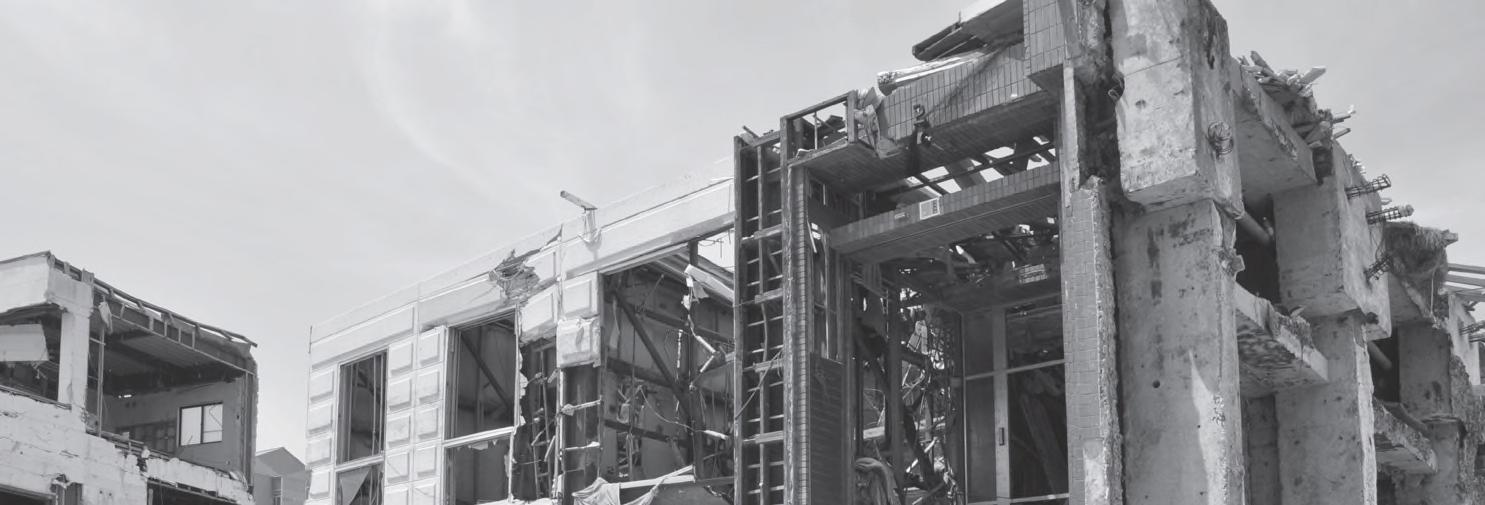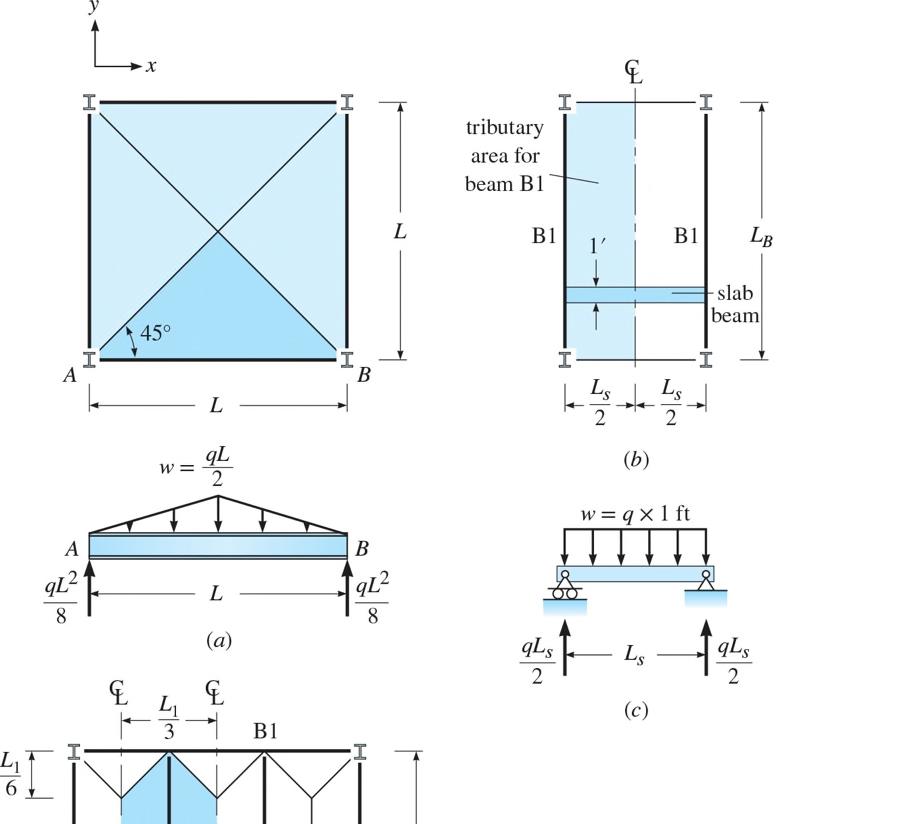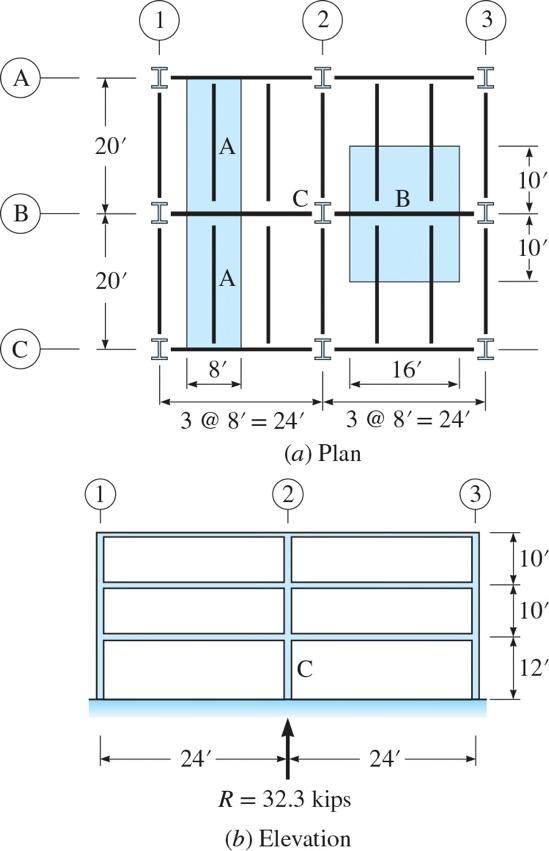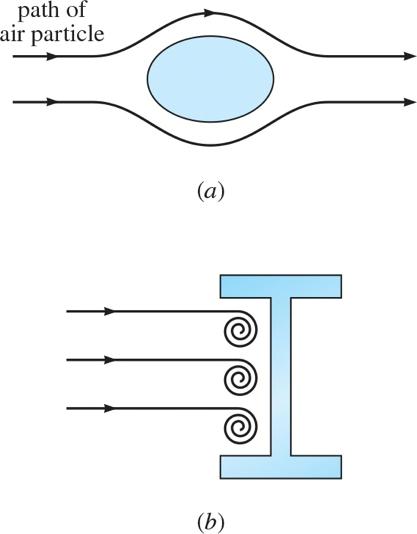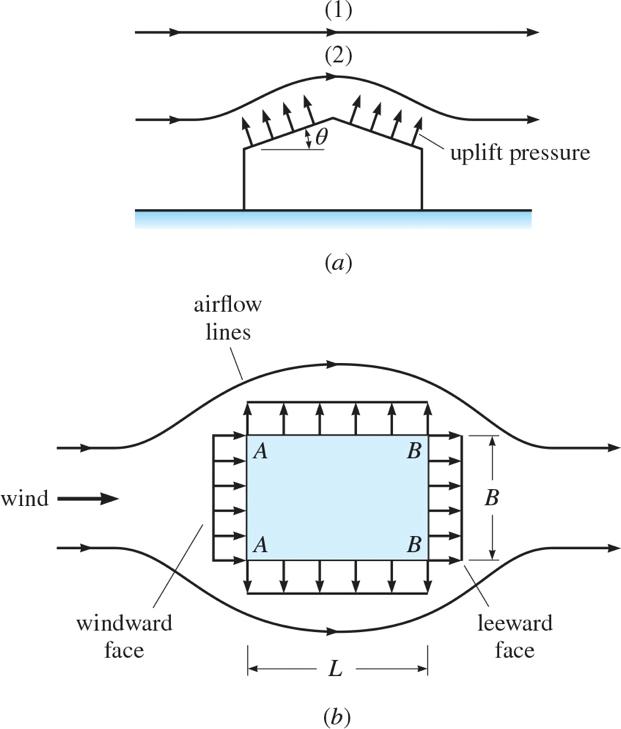
FUNDAMENTALSOF STRUCTURALANALYSIS
5th Edition
Kenneth M. Leet, Chia-Ming Uang, Joel T. Lanning, and Anne M. Gilbert


5th Edition
Kenneth M. Leet, Chia-Ming Uang, Joel T. Lanning, and Anne M. Gilbert
Copyright©2018McGraw-HillEducation.Allrightsreserved. NoreproductionordistributionwithoutthepriorwrittenconsentofMcGraw-HillEducation.
P2.1. Determine the deadweight of a 1-ft-long segment of the prestressed, reinforced concrete tee-beam whose cross section is shown in Figure P2.1. Beam is constructed with lightweight concrete which weighs 120 lbs/ft3.

Compute the weight/ft. of cross section @ 120 lb/ft3
Compute cross sectional area:
Weight of member per foot length: 23 wt/ft7.5ft120lb/ft900 lb/ft.
Copyright©2018McGraw-HillEducation.Allrightsreserved. NoreproductionordistributionwithoutthepriorwrittenconsentofMcGraw-HillEducation.
P2.2. Determine the deadweight of a 1-ft-long segment of a typical 20-in-wide unit of a roof supported on a nominal 2 × 16 in. southern pine beam (the actual dimensions are 1 2 in. smaller). The 3 4 -in. plywood weighs 3 lb/ft2.
Copyright©2018McGraw-HillEducation.Allrightsreserved. NoreproductionordistributionwithoutthepriorwrittenconsentofMcGraw-HillEducation.

P2.3. A wide flange steel beam shown in Figure P2.3 supports a permanent concrete masonry wall, floor slab, architectural finishes, mechanical and electrical systems. Determine the uniform dead load in kips per linear foot acting on the beam.
The wall is 9.5-ft high, non-load bearing and laterally braced at the top to upper floor framing (not shown). The wall consists of 8-in. lightweight reinforced concrete masonry units with an average weight of 90 psf. The composite concrete floor slab construction spans over simply supported steel beams, with a tributary width of 10 ft, and weighs 50 psf.
The estimated uniform dead load for structural steel framing, fireproofing, architectural features, floor finish, and ceiling tiles equals 24 psf, and for mechanical ducting, piping, and electrical systems equals 6 psf.
Uniform Dead Load WDL Acting on the Wide Flange Beam:
Wall Load: 9.5(0.09ksf)0.855klf
Floor Slab: 10(0.05ksf)0.50klf
Steel Frmg, Fireproof’g, Arch’l Features, Floor Finishes, & Ceiling: 10(0.024ksf)0.24klf
Mech’l, Piping & Electrical Systems: 10(0.006 ks
Total1.66klf DLW = =
f)0.06 klf
wide flange steel beam with fireproofing ceiling tile and suspension hangers Section
Copyright©2018McGraw-HillEducation.Allrightsreserved. NoreproductionordistributionwithoutthepriorwrittenconsentofMcGraw-HillEducation.
P2.4. Consider the floor plan shown in Figure
P2.4. Compute the tributary areas for (a) floor beam B1, (b) floor beam B2, (c) girder G1, (d) girder G2, (e) corner column C1, and (f ) interior column C
Copyright©2018McGraw-HillEducation.Allrightsreserved. NoreproductionordistributionwithoutthepriorwrittenconsentofMcGraw-HillEducation.
P2.5. Refer to Figure P2.4 for the floor plan. Calculate the tributary areas for (a) floor beam B3, (b) floor beam B4, (c) girder G3, (d) girder G4, (e) edge column C3, and (f ) corner column C4.
Copyright©2018McGraw-HillEducation.Allrightsreserved. NoreproductionordistributionwithoutthepriorwrittenconsentofMcGraw-HillEducation.
P2.6. The uniformly distributed live load on the floor plan in Figure P2.4 is 60 lb/ft2. Establish the loading for members (a) floor beam B1, (b) floor beam B2, (c) girder G1, and (d) girder G2. Consider the live load reduction if permitted by the ASCE standard.
Copyright©2018McGraw-HillEducation.Allrightsreserved. NoreproductionordistributionwithoutthepriorwrittenconsentofMcGraw-HillEducation.
P2.7. The uniformly distributed live load on the floor plan in Figure P2.4 is 60 lb/ft2. Establish the loading for members (a) floor beam B3, (b) floor beam B4, (c) girder G3, and girder G4. Consider the live load reduction if permitted by the ASCE standard.
psf
Copyright©2018McGraw-HillEducation.Allrightsreserved. NoreproductionordistributionwithoutthepriorwrittenconsentofMcGraw-HillEducation.
P2.8. The building section associated with the floor plan in Figure P2.4 is shown in Figure
P2.8. Assume a live load of 60 lb/ft2 on all three floors. Calculate the axial forces produced by the live load in column C1 in the third and first stories. Consider any live load reduction if permitted by the ASCE standard.
Copyright©2018McGraw-HillEducation.Allrightsreserved. NoreproductionordistributionwithoutthepriorwrittenconsentofMcGraw-HillEducation.
P2.9. The building section associated with the floor plan in Figure P2.4 is shown in Figure
P2.8. Assume a live load of 60 lb/ft2 on all three floors. Calculate the axial forces produced by the live load in column C3 in the third and first stories. Consider any live load reduction if permitted by the ASCE standard.
Copyright©2018McGraw-HillEducation.Allrightsreserved. NoreproductionordistributionwithoutthepriorwrittenconsentofMcGraw-HillEducation.
P2.10. A five-story building is shown in Figure P2.10. Following the ASCE standard, the wind pressure along the height on the windward side has been established as shown in Figure P2.10(c). (a) Considering the windward pressure in the east-west direction, use the tributary area concept to compute the resultant wind force at each floor level. (b) Compute the horizontal base shear and the overturning moment of the building.


a) Resulant Wind Forces
Roof 20 psf (6 × 90) = 10,800 lb
5th floor 20 psf (12 × 90) = 21,600 lb
4th floor 20 psf (2 × 90) + 15 (10 × 90) = 17,100 lb
3rd floor 15 psf (10 × 90) + 13 (2 × 96) = 15,800 lb
2nd floor 13 psf (12 × 90) = 14,040 lb
b) Horizontal Base Shear VBASE = Σ Forces at Each Level =
10.8k + 21.6k + 17.1k + 15.8k + 14.04k = (a)
VBASE = 79.34k
Overturning Moment of the Building =
10.8k (60′)+ 21.6 (48′) + 17.1 (36′) +
15.8k (24′)+ 14.04k(12′) =
M overturning = 2, 848ft.k
Copyright©2018McGraw-HillEducation.Allrightsreserved. NoreproductionordistributionwithoutthepriorwrittenconsentofMcGraw-HillEducation.
P2.11. A mechanical support framing system is shown in Figure P2.11. The framing consists of steel floor grating over steel beams and entirely supported by four tension hangers that are connected to floor framing above it. It supports light machinery with an operating weight of 4000 lbs, centrally located. (a) Determine the impact factor I from the LiveLoadImpact Factor, Table 2.3. (b) Calculate the total live load acting on one hanger due to the machinery and uniform live load of 40 psf around the machine. (c) Calculate the total dead load acting on one hanger. The floor framing dead load is 25 psf. Ignore the weight of the hangers. Lateral bracing is located on all four edges of the mechanical floor framing for stability and transfer of lateral loads.
a) Live Load Impact Factor = 20%
b) Total LL
c) Total DL
Copyright©2018McGraw-HillEducation.Allrightsreserved. NoreproductionordistributionwithoutthepriorwrittenconsentofMcGraw-HillEducation.
P2.12. The dimensions of a 9-m-high warehouse are shown in Figure P2.12. The windward and leeward wind pressure profiles in the long direction of the warehouse are also shown. Establish the wind forces based on the following information: basic wind speed = 40 m/s, wind exposure category = C, Kd = 0.85, K zt = 1.0, G = 0.85, and C p = 0.8 for windward wall and ‒0.2 for leeward wall. Use the K z values listed in Table 2.4. What is the total wind force acting in the long direction of the warehouse?
Use I = 1
2 22 0.613 (Eq. 2.4b) 0.613(40) = 980.8 N/m 980.8(1)()(1)(0.85) = 833.7
4.66.1m:833.7(0.90)750.3N/m
6.1 = 7.6 m: 833.7(0.94) = 783.7 N/m
7.6 = 9 m: 833.7(0.98) = 817.1 N/m
For the Windward Wall = (Eq. 2.7) where = 0.85(0.8) = 0.68 = 0.68
m481.8N/m 4.66.1 m510.2N/m 6.17.6 m532.9N/m 7.69 m555.6N/m
Total Windforce, FW, Windward Wall 481.8[4.6×20] + 510.2[1.5×20] + 532.9[1.5×20] + 555.6[1.4×20]
For Leeward Wall
(0.85)(0.2) at 9m817.1 N/m (above) 817.1 (0.85)(0.2)138.9 N/m
Copyright©2018McGraw-HillEducation.Allrightsreserved. NoreproductionordistributionwithoutthepriorwrittenconsentofMcGraw-HillEducation.
P2.13. The dimensions of an enclosed gabled building are shown in Figure P2.13a. The external pressures for the wind load perpendicular to the ridge of the building are shown in Figure P2.13b. Note that the wind pressure can act toward or away from the windward roof surface. For the particular building dimensions given, the C p value for the roof based on the ASCE standard can be determined from Table P2.13, where plus and minus signs signify pressures acting toward and away from the surfaces, respectively. Where two values of C p are listed, this indicates that the windward roof slope is subjected to either positive or negative pressure, and the roof structure should be designed for both loading conditions. The ASCE standard permits linear interpolation for the value of the inclined angle of roof ��. But interpolation should only be carried out between values of the same sign. Establish the wind pressures on the building when positive pressure acts on the windward roof. Use the following data: basic wind speed = 100 mi/h, wind exposure category = B, Kd = 0.85, K zt = 1.0, G = 0.85, and C p = 0.8 for windward wall and 0.2 for leeward wall.

Consider Positive Windward Pressure on Roof, i.e. left side. Interpolate in Table P2.10
From Table 2.4 (see p48 of text)
Copyright©2018McGraw-HillEducation.Allrightsreserved. NoreproductionordistributionwithoutthepriorwrittenconsentofMcGraw-HillEducation.
P2.13. Continued 2 22
1.0, 0.85, 1
0.00256 (Eq 2.4a) 0.00256(100)25.6 lb/ft
015; 25.6 (1)(0.57)(1)(0.85)
12.40 lb/ft
1516; 13.49 lb/ft 24; 14.36 lb/ft
Wind Pressure on Windward Wall & Roof
Wall 015 12.40×0.85×0.80
8.43 psf
Wall, 151613.49×0.85×0.8 = 9.17 psf
Roof, 14.36×0.85×0.2738
3.34 psf
For Wall
Wind Pressure on Leeward Side 2
For 24; 14.36 lb/ft hp hz
PqGC hqq = ¢ ===
C p ‒0.2 for wall 0.6 for roof 2
2 For .44 Wall lb/ft P P = = 2
14.36 (0.85)(0.2)
14.36 (0.85)(0.6)
For Roo ft(upi f lft) P
7.32 lb/
Copyright©2018McGraw-HillEducation.Allrightsreserved. NoreproductionordistributionwithoutthepriorwrittenconsentofMcGraw-HillEducation.
P2.14. Establish the wind pressures on the building in Problem P2.13 when the windward roof is subjected to an uplift wind force.
See P2.13 Solution Windward Roof (Negative Pressure)
33.7
Interpolate between 30 and 35 for negative C p value in Table P2.12
0.274
p hp
C pqGC ====-
21.76(0.66) 0.85(0.274)
2
3.34 lb/ft (Suction)
Note: Wind pressures on other 3 surfaces are the same as in P2.13.
2-16
Copyright©2018McGraw-HillEducation.Allrightsreserved. NoreproductionordistributionwithoutthepriorwrittenconsentofMcGraw-HillEducation.
TABLE P2.13 Roof Pressure Coefficient C p80ʹ 140ʹ 160ʹ wind 140 mph leeward D C B E F G H A P2.15
zszztd
Eq2.8 0.00256Eq 2.6a 0.00256(140) 50.176 psf; Round to 50.18 psf
ztd I KK = == K z, Read
2
zz zz qK qK = =
(1.15)() 1 (0.85)
49.05
p qz GC p; Use Value of qz at 140 ft. i.c. K z 152 0.549.05(1.52)74.556 74.556 74.556(0.85)(0.5) 31.68 psfANS. pz p Cq pGC p =-== ===Wind Pressure on Side Walls 49.05(1.52)(0.85)(0.7) 44.36 psf zppqGC p ===-
(b) Variation of Wind Pressure on Windward and Leeward Sides
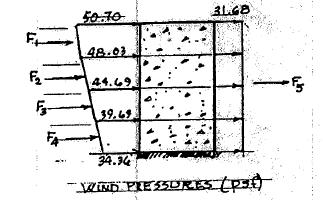
49.05
pkK ==
zz
Elev. (ft) 0 35 70 105 140 p (psf) 34.36 39.69 44.69 48.03 50.70
Copyright©2018McGraw-HillEducation.Allrightsreserved. NoreproductionordistributionwithoutthepriorwrittenconsentofMcGraw-HillEducation.
P2.15. Continued Compute 1 2 3 4 5
Total 50.748.0235160 276.42kips 21000 48.0344.6935160 259.62k 21000 44.6939.6935160 236.26k 21000 39.6934.3635160 207.39k 21000 31.68140160 709.63k 1000
+´éù êú == êú ëû +´éù êú == êú ëû +´éù êú == êú ëû +´éù êú == êú ëû ´ == 12345 TotalWindForceΣ 1689.27kips FFFFF =++++ =
F F F F F
P2.16. Consider the five-story building shown in Figure P2.10. The average weights of the floor and roof are 90 lb/ft2 and 70 lb/ft2, respectively. The values of SDS and SD1 are equal to 0.9g and 0.4g, respectively. Since steel moment frames are used in the north-south direction to resist the seismic forces, the value of R equals 8. Compute the seismic base shear V. Then distribute the base shear along the height of the building.
Copyright©2018McGraw-HillEducation.Allrightsreserved. NoreproductionordistributionwithoutthepriorwrittenconsentofMcGraw-HillEducation.
Copyright©2018McGraw-HillEducation.Allrightsreserved. NoreproductionordistributionwithoutthepriorwrittenconsentofMcGraw-HillEducation.
P2.17. When a moment frame does not exceed 12 stories in height and the story height is at least 10 ft, the ASCE standard provides a simpler expression to compute the approximate fundamental period:
T = 0.1N
where N number of stories. Recompute T with the above expression and compare it with that obtained from Problem P2.16. Which method produces a larger seismic base shear?
ASCE Approximate Fundamental Period:
The simpler approximate method produces a larger value of base shear.
Copyright©2018McGraw-HillEducation.Allrightsreserved. NoreproductionordistributionwithoutthepriorwrittenconsentofMcGraw-HillEducation.
P2.18. (a) A two-story hospital facility shown in Figure P2.18 is being designed in New York with a basic wind speed of 90 mi/h and wind exposure D. The importance factor I is 1.15 and K z 1.0. Use the simplified procedure to determine the design wind load, base shear, and building overturning moment. (b) Use the equivalent lateral force procedure to determine the seismic base shear and overturning moment. The facility, with an average weight of 90 lb/ft2 for both the floor and roof, is to be designed for the following seismic factors: SDS 0.27g and SD1 0.06g; reinforced concrete frames with an R value of 8 are to be used. The importance factor I is 1.5. (c) Do wind forces or seismic forces govern the strength design of the building?
(a) Wind Loads Using Simplified Procedure:
Table 2.8, Mean Roof Height 30ʹ
Copyright©2018McGraw-HillEducation.Allrightsreserved. NoreproductionordistributionwithoutthepriorwrittenconsentofMcGraw-HillEducation.

P2.18. Continued
(b) Seismic Loads by Equivalent Lateral Force Procedure Given:
(c) Seismic Forces Govern the Lateral Strength Design.
Copyright©2018McGraw-HillEducation.Allrightsreserved. NoreproductionordistributionwithoutthepriorwrittenconsentofMcGraw-HillEducation.
P2.19. In the gabled roof structure shown in Figure P2.13, determine the sloped roof snow load P s. The building is heated and is located in a windy area in Boston. Its roof consists of asphalt shingles. The building is used for a manufacturing facility, placing it in a type II occupancy category. Determine the roof slope factor, C s using the ASCE graph shown in Figure P2.19. If roof trusses are spaced at 16 ft on center, what is the uniform snow load along a truss?
with obstructions or non-slippery surfaces
unobstructed slippery surfaces with thermal resistance, R ≥ 30°F·h·ft2/Btu
(5.3°C·m2/W) for unventilated roofs or R ≥ 20°F·h·ft2/Btu
(3.5°C·m2/W) for ventilated roofs
warm
From Fig. P2.17 C s is Approximately 0.9 (Non-Slippery Surface)
)( )( )( )
0.7 0.71.01.040 psf19.6 psf
19.6 psf17.64 psf
Uniform Load Acting on Trusses Spaced @ 16 o.c.
17.64 psf 16282. plf ()2
Copyright©2018McGraw-HillEducation.Allrightsreserved. NoreproductionordistributionwithoutthepriorwrittenconsentofMcGraw-HillEducation.
P2.20. A beam that is part of a rigid frame has end moments and mid-span moments for dead, live, and earth-quake loads shown below. Determine the governing load combination for both negative and positive moments at the ends and mid-span of the beam. Earthquake load can act in either direction, generating both negative and positive moments in the beam.
Copyright©2018McGraw-HillEducation.Allrightsreserved. NoreproductionordistributionwithoutthepriorwrittenconsentofMcGraw-HillEducation.
P2.21. Calculate the vertical hydrostatic load on the 5100-lb empty shipping container in Figure P2.19 subjected to a tsunami inundation height of 3ʹ. Assuming the container is water-tight, will the tsunami wave be capable of carrying away the container as debris?
γ70.4(3)(8)(20)
33792 lbs
33.8 kips
33.8 kips 5.1 kips
s container
Yes, the container will be carried away.
Copyright©2018McGraw-HillEducation.Allrightsreserved. NoreproductionordistributionwithoutthepriorwrittenconsentofMcGraw-HillEducation.
P2.22. Consider the building in Figure P2.22, which has a width into the page of 35 ft. Maximum inundation height, hmax, and flow velocity, umax, have been determined as 33 ft and 20 ft/sec, respectively. Calculate the hydrodynamic and hydrostatic resultant load and location on the walls ABCandIJKL for Load Cases 2 and 3, due to both inflow and outflow directions. If windows are inundated, calculate the expected hydrostatic loading on the adjacent outside walls due to water retained by the floor, or floors. Finally, calculate the debris impact load to be applied to the free-standing column CD. Assume I tsu = 1.0 and Cd = 1.25.
Copyright©2018McGraw-HillEducation.Allrightsreserved. NoreproductionordistributionwithoutthepriorwrittenconsentofMcGraw-HillEducation.




